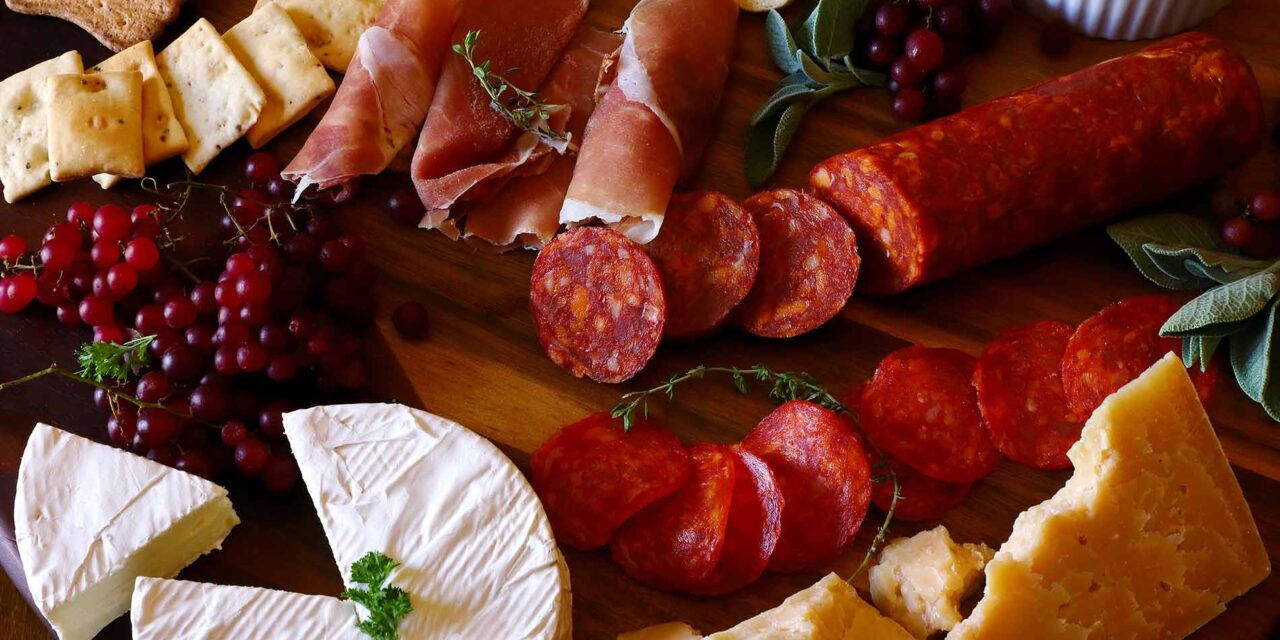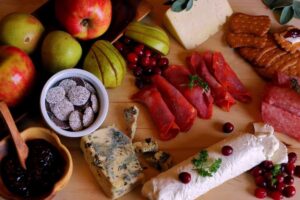by Michael Vyskocil, photography by Nikola Tzenov
How To Build Your Own Charcuterie Board: Artisanal Cheeses And Cured Meats Form The Basics, But There’s More To Building This Delicious Spread Than Meets The Eye
When you’re entertaining guests for the holidays, determining how much food to buy and prepare can sometimes get confusing. Something that will always please guests are artisanal cheeses and cured meats on a charcuterie board. On the following pages, you’ll find three dynamic ideas for charcuterie spreads you can tailor to the size of any gathering.
 A charcuterie board makes the perfect offering for formal dinner parties or casual entertaining. If you’re planning to prepare a main course with many side dishes, you may want to go with a simple, scaled-down version shown at the bottom of page 61. We kept things simple with this approach and selected one premier cheese and one quality meat. For presentation, consider leaving the cheese whole and your meat partially sliced. To complete the look of this charcuterie board, add some crisp crackers or slices of toasted bread and a savory jam or chutney in a small bowl.
A charcuterie board makes the perfect offering for formal dinner parties or casual entertaining. If you’re planning to prepare a main course with many side dishes, you may want to go with a simple, scaled-down version shown at the bottom of page 61. We kept things simple with this approach and selected one premier cheese and one quality meat. For presentation, consider leaving the cheese whole and your meat partially sliced. To complete the look of this charcuterie board, add some crisp crackers or slices of toasted bread and a savory jam or chutney in a small bowl.
Make an edible centerpiece for your holiday table. When selecting your board, go with a piece that will make just as much of a statement as the edibles you place atop it. To create this charcuterie centerpiece (at right), we selected three cheeses and two cured meats and casually arranged them on the board. Vary the ratio of cheeses to meats, depending on how many products you want your guests to sample. When selecting cheeses, aim for balance — hard cheeses and soft, sharp cheeses and those with more mellow flavors.
With so much fresh, autumnal fruit available in Carroll County at this time of year, you’ll want to incorporate a seasonal fruit element into your charcuterie board. The sweetness of the fruit helps to balance out the salty flavor profiles of the cheeses and the meats. To make your board visually pleasing, go for items that offer strong shots of color, such as ruby-red pomegranate seeds. Bowls of specialty jams, jellies, mustards and spreads are not only appealing for spreading on toasted bread slices or crackers, but they also add visual interest to your charcuterie presentation.
When planning a large party, you’ll need to scale up your charcuterie offerings. Having three to five cheeses and several types of meat ensures each guest can walk away with something to satisfy. To keep your board from looking too crowded, consider stacking or arranging your items in neat lines or patterns. Fresh, tart apple wedges or dried raisins or currants can temper the sharp and spicy flavors of the meats and cheeses. Fill small bowls with spreads and place them within easy reach of the board.
Local Charcuterie Sources
Giulianova Groceria
11 E. Main St., Westminster
410-876-7425 • brothersun.biz
Imported and domestic deli meats, along with various imported and domestic cheeses
Market Tavern
7556 Main St., Sykesville
443-609-6122 • market-tavern.com
Artisan spreads, fresh cheeses, gourmet snacks, spreads and seasonings
Rare Opportunity Bakehouse
172 E. Main St., Westminster
410-598-9409 • rareopportunitybakehouse.com
Jams and jellies
Cheers to Snacks – Beth Sebian
233 E. Main St., Westminster
443-487-6225 • cheerstosnacks@gmail.com
Serves Carroll County with charcuterie and grazing tables for special events, plus charcuterie classes
Charcuterie board tips
Cheeses with a firmer texture or hard rind are best served cut into bite-size pieces. Pair these cheeses with softer, spreadable cheeses such as brie or Camembert. When choosing cheeses, aim for a selection of colors, textures and flavors.
How much meat should you serve on a charcuterie board? Plan on three to four slices of meat per person when you’re purchasing your prosciutto, soppressata or capocollo.
Keep things tidy on your board with groupings of ingredients. For example, place marinated artichoke hearts or a selection of olives in small bowls with spoons.
Use fresh herb sprigs, cranberries and chestnuts as natural decorations for your charcuterie spread.
Choosing your cheeses and meats
One of the beauties of creating a charcuterie spread is customizing the ingredients to your tastes. Below are some examples of the types of meats and cheeses you can include:
Soft-rind cheeses are fresh cheeses that are aged slightly, approximately two to 12 months depending on the variety. Chevre (also known as goat cheese) offers a soft texture that’s easily spreadable on toast points or crackers. Cheeses like a Bucheron, a French cheese, have a soft rind that you can easily cut into. Creating an entry point into the cheeses, such as cutting wedges or slicing them into circles, invites your guests to sample the cheeses for themselves. Other soft-rind cheeses are brie and Camembert.
Semi-firm cheeses such as Gruyere are excellent for picking up off the board and popping into your mouth while enjoying a sip of wine. Semi-firm cheeses are aged longer than soft-rind cheeses and have a firmer texture but remain soft and easy to cut. If you can’t find Gruyere, you could substitute a cheddar in its place.
Hard cheeses are those with a much firmer texture. Parmesan and pecorino are two types of hard cheeses you can include.
Blue cheeses, such as Roquefort, offer fragrance and texture to your charcuterie board. Gorgonzola and Maytag are two other blue cheeses that can also work here.
Cured meats such as jamon serrano or prosciutto complement your cheese selections. Dried sausages are also delicious sliced into thin rounds and artfully arranged on the board.



